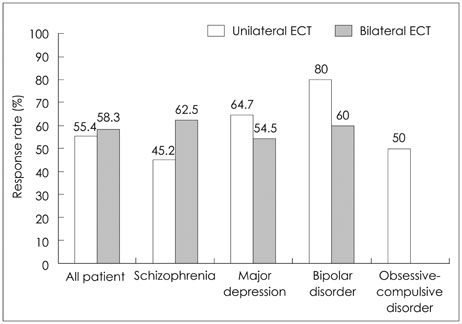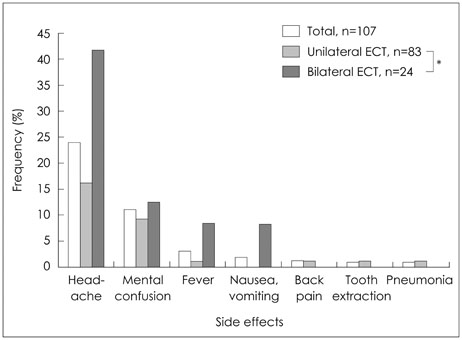J Korean Neuropsychiatr Assoc.
2015 Aug;54(3):330-337. 10.4306/jknpa.2015.54.3.330.
Clinical Effectiveness of Electroconvulsive Therapy in a University Hospital Setting
- Affiliations
-
- 1Department of Psychiatry, Keimyung University School of Medicine, Daegu, Korea. mdhck@dsmc.or.kr
- 2Keimyung University Brain Research Institute, Daegu, Korea.
- KMID: 2035967
- DOI: http://doi.org/10.4306/jknpa.2015.54.3.330
Abstract
OBJECTIVES
Electroconvulsive therapy (ECT) has become useful in psychiatric practice. This study was conducted to describe the clinical practice of ECT, including indications, efficacy, and side effects, in patients treated with modified unilateral or bilateral ECT.
METHODS
The clinical records of patients treated with ECT during the period of January 2002 to December 2013 were evaluated retrospectively. A total of 107 patients (83 unilateral and 24 bilateral) were included in the analysis. Diagnostic categories treated were schizophrenia (46.7%), major depression (42.1%), bipolar disorder (9.3%), and obsessive-compulsive disorder (1.9%). Right unilateral or bilateral ECT was administered with brief pulse stimulation using modified ECT. Severity of illness and clinical improvement were measured using the Clinical Global Impressions (CGI) Scale.
RESULTS
A positive response to ECT was found in 56.1% according to response criteria of the CGI-Improvement (CGI-I) score of 1 or 2. Response rates (based on CGI-I < or =2) for schizophrenia, major depression, bipolar disorder, and obsessive-compulsive disorder were 48.0%, 62.2%, 70.0%, and 50.0%, respectively (p=0.42). Although unilateral and bilateral ECT did not differ in rates of response, bilateral ECT resulted in more rapid onset of improvement. Bilateral ECT showed association with more adverse side effects (unilateral 31.3% vs. bilateral 70.8%).
CONCLUSION
ECT is a highly effective and safe therapeutic option in the treatment of psychiatric illness, particularly in major mood disorder and schizophrenia. The use of ECT in a university hospital psychiatric unit in South Korea reflects similar results to those described in the international literature.
Keyword
MeSH Terms
Figure
Cited by 2 articles
-
Recent Trends for Optimization of Electroconvulsive Therapy
Tak Youn, Ung Gu Kang, Yong Sik Kim, In Won Chung
J Korean Neuropsychiatr Assoc. 2016;55(1):12-24. doi: 10.4306/jknpa.2016.55.1.12.Effectiveness and Safety of Electroconvulsive Therapy in Clinical Practice
Sung Woo Joo, Ha Eun Jeong, Myong-Wuk Chon, Yeon Ho Joo, Chang Yoon Kim, Jung Sun Lee
J Korean Neuropsychiatr Assoc. 2016;55(3):202-208. doi: 10.4306/jknpa.2016.55.3.202.
Reference
-
1. Trimble MR, Thompson PJ. Neuropsychological and behavioral sequelae of spontaneous seizures. Ann N Y Acad Sci. 1986; 462:284–292.
Article2. Beveridge AW, Renvoize EB. Electricity: a history of its use in the treatment of mental illness in Britain during the second half of the 19th century. Br J Psychiatry. 1988; 153:157–162.
Article3. Thompson JW, Weiner RD, Myers CP. Use of ECT in the United States in 1975, 1980, and 1986. Am J Psychiatry. 1994; 151:1657–1661.
Article4. Kane J, Honigfeld G, Singer J, Meltzer H. Clozapine for the treatment-resistant schizophrenic. A double-blind comparison with chlorpromazine. Arch Gen Psychiatry. 1988; 45:789–796.5. Van Putten T, Marder SR, Mintz J. A controlled dose comparison of haloperidol in newly admitted schizophrenic patients. Arch Gen Psychiatry. 1990; 47:754–758.
Article6. Painuly N, Chakrabarti S. Combined use of electroconvulsive therapy and antipsychotics in schizophrenia: the Indian evidence. A review and a meta-analysis. J ECT. 2006; 22:59–66.
Article7. Chanpattana W, Chakrabhand ML, Sackeim HA, Kitaroonchai W, Kongsakon R, Techakasem P, et al. Continuation ECT in treatmentresistant schizophrenia: a controlled study. J ECT. 1999; 15:178–192.8. Pagnin D, de Queiroz V, Pini S, Cassano GB. Efficacy of ECT in depression: a meta-analytic review. J ECT. 2004; 20:13–20.
Article9. Husain MM, Rush AJ, Fink M, Knapp R, Petrides G, Rummans T, et al. Speed of response and remission in major depressive disorder with acute electroconvulsive therapy (ECT): a Consortium for Research in ECT (CORE) report. J Clin Psychiatry. 2004; 65:485–491.
Article10. Hiremani RM, Thirthalli J, Tharayil BS, Gangadhar BN. Doubleblind randomized controlled study comparing short-term efficacy of bifrontal and bitemporal electroconvulsive therapy in acute mania. Bipolar Disord. 2008; 10:701–707.
Article11. Mohan TS, Tharyan P, Alexander J, Raveendran NS. Effects of stimulus intensity on the efficacy and safety of twice-weekly, bilateral electroconvulsive therapy (ECT) combined with antipsychotics in acute mania: a randomised controlled trial. Bipolar Disord. 2009; 11:126–134.
Article12. American Psychiatric Association. Practice guideline for the treatment of patients with bipolar disorder (revision). Am J Psychiatry. 2002; 159:4 Suppl. 1–50.13. Practice guideline for the treatment of patients with major depressive disorder (revision). American Psychiatric Association. Am J Psychiatry. 2000; 157:4 Suppl. 1–45.14. Pippard J. Audit of electroconvulsive treatment in two national health service regions. Br J Psychiatry. 1992; 160:621–637.
Article15. Fergusson GM, Cullen LA, Freeman CP, Hendry JD. Electroconvulsive therapy in Scottish clinical practice: a national audit of demographics, standards, and outcome. J ECT. 2004; 20:166–173.
Article16. Hermann RC, Dorwart RA, Hoover CW, Brody J. Variation in ECT use in the United States. Am J Psychiatry. 1995; 152:869–875.
Article17. Coffey CE, Lucke J, Weiner RD, Krystal AD, Aque M. Seizure threshold in electroconvulsive therapy: I. Initial seizure threshold. Biol Psychiatry. 1995; 37:713–720.
Article18. Guy W. ECDEU assessment manual for psychopharmacology. US Department of Health, Education, and Welfare, Public Health Service, Alcohol, Drug Abuse, and Mental Health Administration, National Institute of Mental Health, Psychopharmacology Research Branch, Division of Extramural Research Programs;1976.19. Leucht S, Engel RR. The relative sensitivity of the Clinical Global Impressions Scale and the Brief Psychiatric Rating Scale in antipsychotic drug trials. Neuropsychopharmacology. 2006; 31:406–412.
Article20. Kristensen D, Bauer J, Hageman I, Jørgensen MB. Electroconvulsive therapy for treating schizophrenia: a chart review of patients from two catchment areas. Eur Arch Psychiatry Clin Neurosci. 2011; 261:425–432.
Article21. Medda P, Mauri M, Toni C, Mariani MG, Rizzato S, Miniati M, et al. Predictors of remission in 208 drug-resistant depressive patients treated with electroconvulsive therapy. J ECT. 2014; 30:292–297.
Article22. Mukherjee S, Sackeim HA, Schnur DB. Electroconvulsive therapy of acute manic episodes: a review of 50 years' experience. Am J Psychiatry. 1994; 151:169–176.
Article23. UK ECT Review Group. Efficacy and safety of electroconvulsive therapy in depressive disorders: a systematic review and meta-analysis. Lancet. 2003; 361:799–808.24. Chanpattana W, Sackeim HA. Electroconvulsive therapy in treatment-resistant schizophrenia: prediction of response and the nature of symptomatic improvement. J ECT. 2010; 26:289–298.
Article25. Sadock BJ, Sadock VA, Ruiz P. Kaplan & Sadock Synopsis of psychiatry: behavioral sciences/clinical psychiatry. 11th ed. Baltimore, MD: Williams & Wilkins;2014. p. 1071–1072.26. American Psychiatric Association. The Practice of electroconvulsive therapy: recommendations for treatment, training, and privileging (a task force report of the American Psychiatric Association). 2nd ed. Washington, DC: American Psychiatric Association;2008. p. 5–25.27. Herzberg F. Prognostic variables for electro-shock therapy. J Gen Psychol. 1954; 50:79–86.
Article28. Kalinowsky LB, Worthing HJ. Results with electric convulsive therapy in 200 cases of schizophrenia. Psychiat Quart. 1943; 17:144–153.
Article29. Dombrovski AY, Mulsant BH, Haskett RF, Prudic J, Begley AE, Sackeim HA. Predictors of remission after electroconvulsive therapy in unipolar major depression. J Clin Psychiatry. 2005; 66:1043–1049.
Article30. Kindler S, Shapira B, Hadjez J, Abramowitz M, Brom D, Lerer B. Factors influencing response to bilateral electroconvulsive therapy in major depression. Convuls Ther. 1991; 7:245–254.31. Petrides G, Fink M, Husain MM, Knapp RG, Rush AJ, Mueller M, et al. ECT remission rates in psychotic versus nonpsychotic depressed patients: a report from CORE. J ECT. 2001; 17:244–253.
Article32. Fink M. Predictors of outcome in convulsive therapy. Psychopharmacol Bull. 1982; 18:50–57.33. de Vreede IM, Burger H, van Vliet IM. Prediction of response to ECT with routinely collected data in major depression. J Affect Disord. 2005; 86:323–327.
Article34. Prudic J, Haskett RF, Mulsant B, Malone KM, Pettinati HM, Stephens S, et al. Resistance to antidepressant medications and shortterm clinical response to ECT. Am J Psychiatry. 1996; 153:985–992.
Article35. O'Connor MK, Knapp R, Husain M, Rummans TA, Petrides G, Smith G, et al. The influence of age on the response of major depression to electroconvulsive therapy: a C.O.R.E. Report. Am J Geriatr Psychiatry. 2001; 9:382–390.36. Small JG, Klapper MH, Kellams JJ, Miller MJ, Milstein V, Sharpley PH, et al. Electroconvulsive treatment compared with lithium in the management of manic states. Arch Gen Psychiatry. 1988; 45:727–732.
Article37. Schnur DB, Mukherjee S, Sackeim HA, Lee C, Roth SD. Symptomatic predictors of ECT response in medication-nonresponsive manic patients. J Clin Psychiatry. 1992; 53:63–66.38. Dunne RA, McLoughlin DM. Systematic review and meta-analysis of bifrontal electroconvulsive therapy versus bilateral and unilateral electroconvulsive therapy in depression. World J Biol Psychiatry. 2012; 13:248–258.
Article39. Sackeim HA, Prudic J, Devanand DP, Nobler MS, Lisanby SH, Peyser S, et al. A prospective, randomized, double-blind comparison of bilateral and right unilateral electroconvulsive therapy at different stimulus intensities. Arch Gen Psychiatry. 2000; 57:425–434.
Article40. Dowman J, Patel A, Rajput K. Electroconvulsive therapy: attitudes and misconceptions. J ECT. 2005; 21:84–87.
- Full Text Links
- Actions
-
Cited
- CITED
-
- Close
- Share
- Similar articles
-
- Combined Clozapine and Electroconvulsive Therapy in a Japanese Schizophrenia Patient: A Case Report
- Anesthetic care for electroconvulsive therapy during pregnancy: A case report
- Satisfaction Survey of Patients Toward Electroconvulsive Therapy
- Anesthetic Management during Electroconvulsive Therapy
- Electroconvulsive Therapy for Treatment-Refractory Behaviors Problems in Neurodevelopmental Disorders




